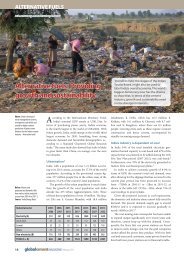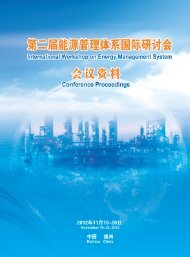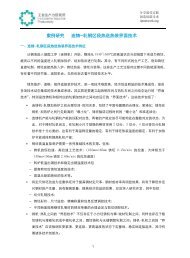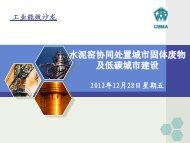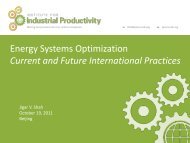Strategic Plan - Institute for Industrial Productivity
Strategic Plan - Institute for Industrial Productivity
Strategic Plan - Institute for Industrial Productivity
You also want an ePaper? Increase the reach of your titles
YUMPU automatically turns print PDFs into web optimized ePapers that Google loves.
IIP Vision <strong>for</strong> Industry<br />
By 2020, advanced technologies and<br />
energy management practices will be in<br />
broad use across industry—significantly<br />
reducing life-cycle process and product<br />
energy requirements; usage intensities<br />
<strong>for</strong> energy, water, and other resources;<br />
and associated carbon emissions. This<br />
industrial culture change will energize<br />
economic growth and help mitigate severe<br />
climate impacts. Supportive government<br />
policies and a public-private network <strong>for</strong><br />
sharing best practices and results will<br />
reduce carbon intensity and encourage<br />
greener manufacturing.<br />
By 2030, the industrial sector will<br />
make rigorous use of a wide range of<br />
smart manufacturing practices such<br />
as innovative materials and processes,<br />
automation and control systems, cradleto-cradle<br />
design, full cost accounting,<br />
industrial ecology principles, and carbon<br />
mitigation strategies. These practices will<br />
further boost industrial productivity and<br />
significantly lower the carbon intensities of<br />
energy and materials use while providing<br />
sustainable solutions to the global energy<br />
economy.<br />
By 2050, industrial hubs will<br />
be models of green industry,<br />
demonstrating integrated, optimized,<br />
networked, next-generation systems to<br />
minimize carbon intensity throughout<br />
the supply chain (e.g., closed-loop<br />
manufacturing systems with near-zero<br />
discharge). Significant use of renewable<br />
energy sources, highly efficient<br />
manufacturing processes, recycling,<br />
and carbon capture and re-use will<br />
enable high-quality industrial products<br />
with minimal embodied energy and lost<br />
carbon.<br />
IIP Goals<br />
IIP activities are designed to achieve two overarching goals:*<br />
••<br />
Drive a reduction in industrial energy intensity averaging 3.5% per year through 2030 in<br />
China, India, and the United States through 2030.<br />
••<br />
Contribute to a 25% reduction in annual GHG emissions by 2020 (avoiding 2.0 GtCO 2<br />
per year) and a 50% reduction by 2030 (avoiding 2.7 GtCO 2<br />
per year) in the industrial<br />
sectors of these countries.<br />
Historical and Goal-based Reductions in Energy Intensity and CO 2<br />
Emissions through 2030<br />
Note: <strong>Industrial</strong> energy intensity in 2000 U.S. dollars.<br />
Source: UNIDO <strong>Industrial</strong> Development Report 2011 (historical data), IIP Goals (projections)<br />
* Basis of goals: Reaching the aggressive yet achievable IIP goal of reducing energy intensity 3.5% per year compared to<br />
baseline projections would provide a 25% decrease in industrial final energy use and emissions in 2020, compared to<br />
baseline projections. Achieving a 50% reduction in industrial GHG emissions by 2030 will require emissions reductions<br />
beyond the 3.5% annual improvement in energy intensity relative to baseline projections. These reductions are most likely to<br />
be achieved through fuel switching (including low-carbon electrification) and limited application of industrial carbon capture,<br />
storage, and reuse.





